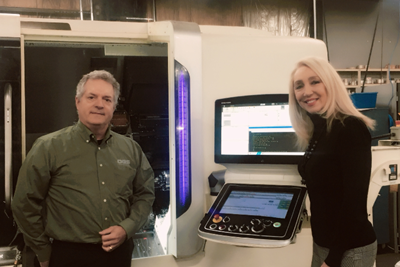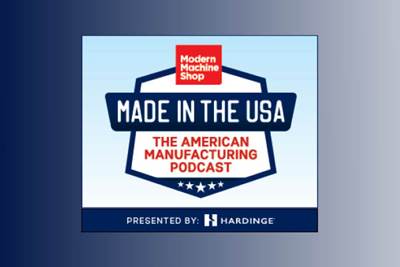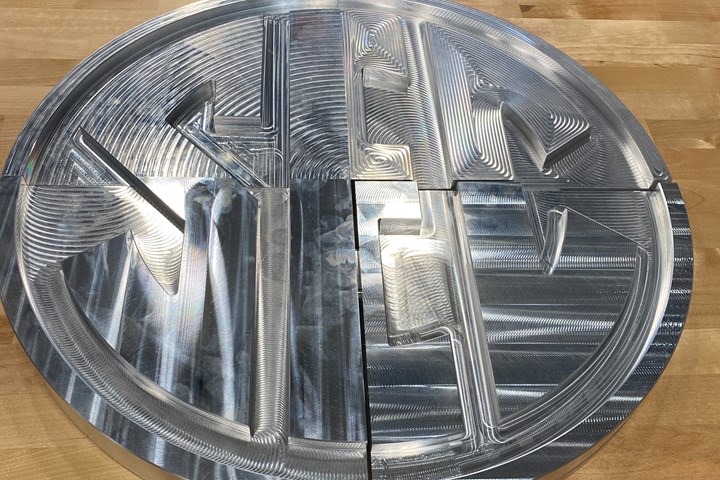
Each of the four teams participating in the inaugural SEC Machining Competition was challenged to machine one quadrant of this metal SEC logo. The winner was chosen based on criteria including cost, time and part quality.
The Southeastern Conference (SEC) has a storied legacy of athletic achievement. Founded in 1932, the schools in this college athletic conference have won 205 national championships across nine men’s and 12 women’s sanctioned sports. But, as a recent event proves, the rivalry and success of these schools extends beyond athletics.
“The Southeastern Conference is all about competition,” says Tony Schmitz, professor in the mechanical, aerospace and biomedical engineering department at the University of Tennessee. “Athletics is what we usually think of in this case, and I wanted to extend that to be in manufacturing.” Schmitz is the organizer of the first SEC Machining Competition, which took place which took place on Friday, November 18. Teams from four SEC schools — the University of Tennessee, Auburn University, Mississippi State University and Texas A&M University — met at the University of Tennessee’s campus in Knoxville to take part.
The goal of the competition, according to Schmitz, is to highlight machining as an essential domestic capability. “The reason machining is important today is both for the US economy and to support the Department of Defense's missions,” he says. Students from local schools served as spectators for the first installment of the event, which also included a college and career fair where representatives from schools and companies provided information about careers in manufacturing.
Breaking (And Fixing) the Chains
The timing couldn’t be better for an event like this, according to Scott Smith, group leader for intelligent machine tools and section head for precision manufacturing and machining at Oak Ridge National Laboratory. (Smith was also the lead judge for the competition). The COVID-19 pandemic highlighted supply chain weaknesses, bringing more awareness to the general public about the importance of manufacturing. “We see this supply chain issue, and it's still fixable,” he explains. “But we have to make a concerted effort to fix it. And trying to attract more students into this profession is a critical part of that.”
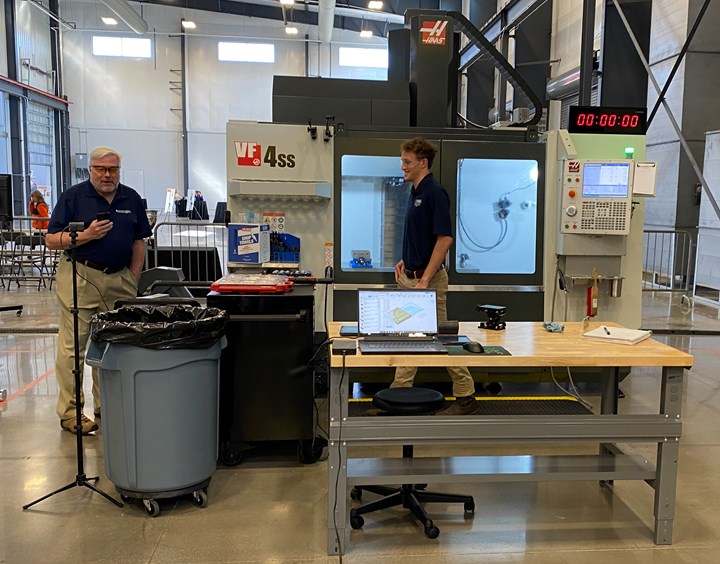
Scott Smith, group leader for intelligent machine tools, and section head for precision manufacturing and machining at Oak Ridge National Laboratory, served as head judge for the competition. He says that attracting more students to manufacturing is critical to solving supply chain problems.
Adele Ratcliff, director of the Manufacturing Resiliency & Assurance office and the Industrial Base Analysis & Sustainment (IBAS) program within the Office of the Deputy Assistant Secretary of Defense for Manufacturing and Industrial Base Policy, agrees. “As we look to rebuild critical supply chains for economic and national security, we need to regrow those training pipelines and reinforce a prestigious moment for manufacturing,” she says.
This issue is so important to IBAS, a Department of Defense program that’s dedicated to supporting and addressing issues with the country’s industrial base, that the organization helped fund the event. Additional sponsors included MSC Industrial Supply, which worked with teams to select cutting tools and donated tooling for the event, the Gene Haas Foundation, which helped provide the VF-4SS VMCs the teams used, and Zeiss, which sent a technician to measure the parts for the final judging.
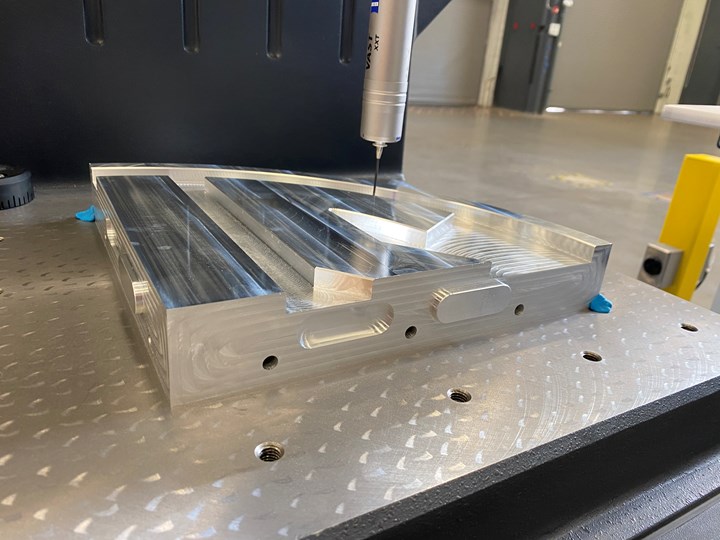
Zeiss, one of the sponsors of the SEC Machining Competition, sent a technician and CMM to measure the machined parts for judging. Other sponsors included MSC Industrial Supply, which donated cutting tools, the Gene Haas Foundation, which helped provide the machine tools, and the Industrial Base Analysis & Sustainment Program (IBAS), a Department of Defense program that’s dedicated to supporting and addressing issues with the country’s industrial base.
Nothing But Net-Shape Parts
The competition itself was fairly straightforward. “We elected to take the Southeastern Conference logo, make it really big, and then separate it into four quadrants,” Schmitz explains. “Each one of the four teams then received the drawing for one of those quadrants, and that was the part that they needed to machine for the competition, which in showing our competitive but friendly nature, we then assemble into one logo.” Teams received their part drawings in the weeks before the competition, giving them time to write programs, select cutting tools, devise workholding strategies and generally establish the machining process. Students also participated in America’s Cutting Edge (ACE), a free online program from IACMI—The Composites Institute that provides training in CNC machining. On the day of the event, teams were given four hours to machine their parts, after which they were measured for judging. The winner was determined based on a judging rubric that included factors such as cost (in terms of tooling and personnel), time, and quality (part geometry and tolerances).
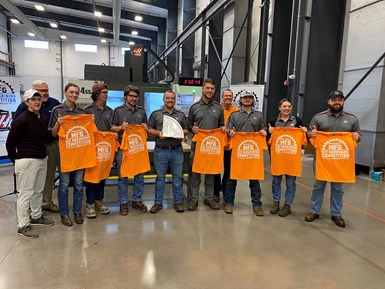
The Texas A&M team with its final part at the SEC Machining Competition.
Teamwork Makes the Machines Work
Although the student competitors came from different schools, they were excited to learn from one another. “I think there are no rivals here, it’s really just teamwork,” said Alyssa Bird, a manufacturing engineering student at Texas A&M University. “It's cool seeing what other teams are doing, talking to other teams about the way they've approached making the part.”
“I think it's so important that all these different schools come together
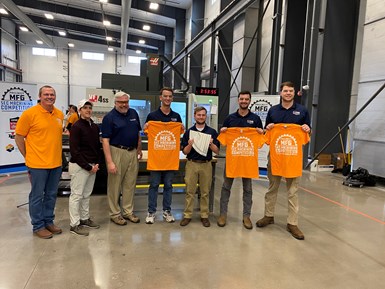
The Auburn University team with its final part at the SEC Machining Competition.
here because it really gives us an opportunity to exchange ideas,” said Scott Neff, a graduate research assistant and PhD student in mechanical engineering at Auburn University. “We have four very similar parts. But I guarantee you, you're going to see four very different ways of machining the same part. I think it's great exposure, great networking, and a great opportunity to soak up all these other ideas that may be out there.”
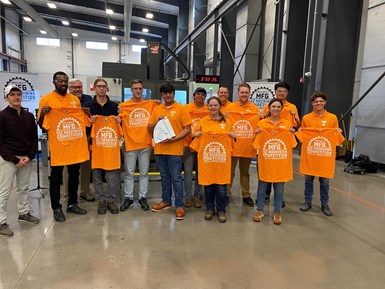
The University of Tennessee team with its final part at the SEC Machining Competition.
The friendly competition also highlighted the creative aspects of machining. “There's a fun side to the whole manufacturing aspect,” said Tyler Poon, a second-year grad student studying mechanical engineering at the University of Tennessee. “And especially for us as a younger generation, we have something to kind of build off of and look forward to. The idea for this is to keep going. So I think, as teams, we’re already getting excited about what's going to happen next year and who else is going to be involved.”
But beyond having fun, the students gained valuable knowledge through
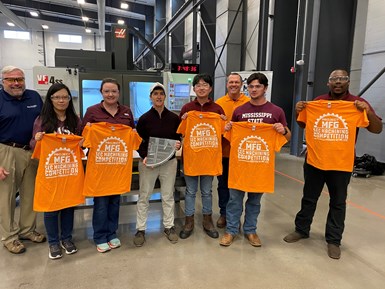
The Mississippi State team with its final part at the SEC Machining Competition.
participating. “I believe that I built some strong skills and teamwork that I was lacking before,” said Christopher Donovan Hopson Jr., a junior studying industrial technology at Mississippi State University. “And I also learned skills with CNC machining and CAD that I didn't know before. So I think I can take that with me throughout the rest of my career. I'm forever thankful for that and I look forward to coming back next year.”
Watch the video to see highlights of the competition and find out which team won:
Related Content
Can Connecting ERP to Machine Tool Monitoring Address the Workforce Challenge?
It can if RFID tags are added. Here is how this startup sees a local Internet of Things aiding CNC machine shops.
Read MoreAll-Around Mill Improves Productivity and Cost for Valve Job
Adopting a mill with a double-negative rake and pockets compatible with multiple insert geometries enabled Progressive Metal Service to increase feed and lower scrap rates for a valve.
Read MoreSolve Worker Shortages With ACE Workforce Development
The America’s Cutting Edge (ACE) program is addressing the current shortage in trained and available workers by offering no-cost online and in-person training opportunities in CNC machining and metrology.
Read MoreA Career at the Top Helps Rebuild a Job Shop
A new approach to management propels expansion into Swiss-type and multitasking machining work.
Read MoreRead Next
Back to School: CNC School Co-Locates With Machine Shop
By allowing this CNC school to operate inside its facility, this machine shop benefits as much as the school does.
Read MoreMade in the USA - Season 1 Episode 4: Making the Case for Manufacturing
The majority of Americans want to "bring manufacturing back" to the U.S. The problem? Many of these same people do not want their children to work in manufacturing because of outdated beliefs about what a machine shop looks like.
Read MoreWill the “Great Resignation” Become an Opportunity for Manufacturers? Get Ready for the Returning 3 Million
The Great Resignation will become a Great Reapplication when employees currently able to stay out of the workforce return to it looking for something better. Machining employers that are already evaluating candidates for fit, without demanding specific skills coming in, might be positioned well to draw upon this wave.
Read More


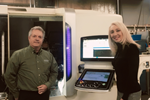
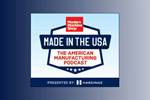














.png;maxWidth=300;quality=90)


.png;maxWidth=300;quality=90)






